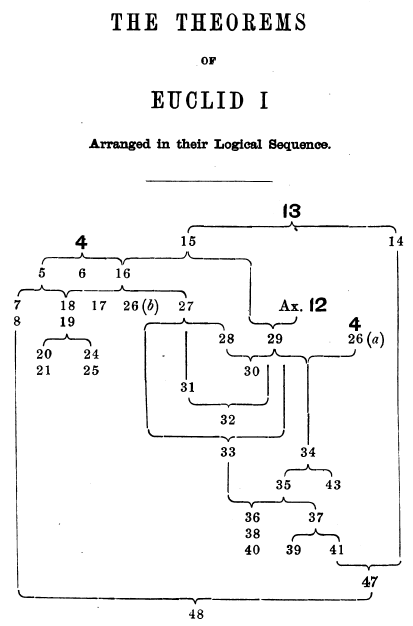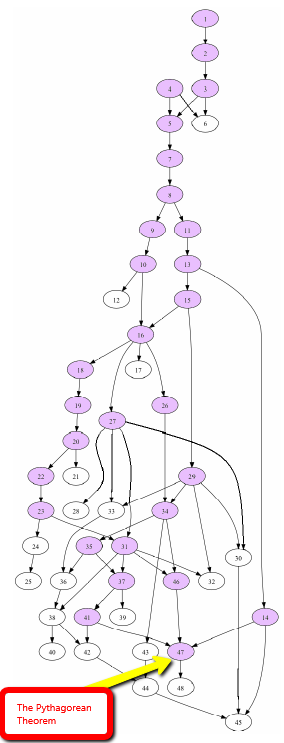- About MAA
- Membership
- MAA Publications
- Periodicals
- Blogs
- MAA Book Series
- MAA Press (an imprint of the AMS)
- MAA Notes
- MAA Reviews
- Mathematical Communication
- Information for Libraries
- Author Resources
- Advertise with MAA
- Meetings
- Competitions
- Programs
- Communities
- MAA Sections
- SIGMAA
- MAA Connect
- Students
- MAA Awards
- Awards Booklets
- Writing Awards
- Teaching Awards
- Service Awards
- Research Awards
- Lecture Awards
- Putnam Competition Individual and Team Winners
- D. E. Shaw Group AMC 8 Awards & Certificates
- Maryam Mirzakhani AMC 10 A Awards & Certificates
- Two Sigma AMC 10 B Awards & Certificates
- Jane Street AMC 12 A Awards & Certificates
- Akamai AMC 12 B Awards & Certificates
- High School Teachers
- News
You are here
Euclid21: Euclid's Elements for the 21st Century - An Idea Forms
On the inside of the front cover of Euclid and his Modern Rivals [1], Dodgson offered the visual display of the logical structure of the first book of The Elements shown in Figure 1.

Figure 1. Dodgson's partial graph of Euclid's Book I in his Euclid and his Modern Rivals (1879) [1]
It was this question of the logical structure of the propositions in The Elements that began our project. In the spring semester of 2010 the first author (hereafter to be referred to in the first person) was teaching a college course in geometry for the first time. While the class was discussing the Pythagorean Theorem (Book 1, Prop. 47), I mentioned to them that I had once been told that Book 1 is organized around the proof of the Pythagorean Theorem, but I did not know if this was true. This was just an off-the-cuff remark but I became so intrigued by the idea that during an idle moment I took out my copy of The Elements and began to sketch out which propositions the Pythagorean Theorem depends on. Had I been familiar with Dodgson's book at the time I would certainly have simply referred to it and this project would never have begun. Instead in about 15 minutes I had the sketch in Figure 2.

Figure 2. My first attempt at a partial graph of Euclid's Book I
This is obviously incomplete and almost certainly inaccurate. I was still intrigued but because I had to get to my next class I put my sketch aside.
I revisited this idea the following fall. As a course project, Brett Eyer, a student in my History of Mathematics course that semester, extended my diagram by creating a complete dependency graph of all of the propositions in the first book of Euclid. He presented a short talk with the chart in Figure 3 at the Fall 2010 meeting of the Eastern Pennsylvania and Delaware (EPaDel) section of the MAA.

Figure 3. Eyer's graph of Euclid’s Book I
Eyer's chart, more complete than either mine or Dodgson's, clearly refutes the idea that Book 1 is organized around the Pythagorean Theorem. Only the purple-shaded propositions support the Pythagorean Theorem, either directly or indirectly. In particular, Propositions 12, 17, 21, 25, 28, 40 and 45 are proved but never used in Book 1. The Pythagorean Theorem is clearly a focal point of Book 1, but it is not the focal point.
This begs the question, “Are the propositions listed above used elsewhere in The Elements?” Also, “Are there propositions which are proved but never used anywhere in The Elements?”
Eugene Boman (Pennsylvania State University, Harrisburg), Alexandra Milbrand (Florida Atlantic University), Tyler Brown (Iowa State University), Siddharth Dahiya (Pennsylvania State University, Harrisburg), Joseph Roberge (Pennsylvania State University, Harrisburg), and Mary Boman (Bryn Mawr College), "Euclid21: Euclid's Elements for the 21st Century - An Idea Forms," Convergence (December 2014)




